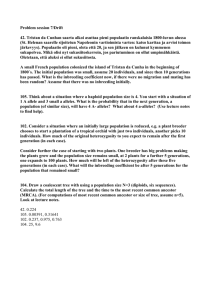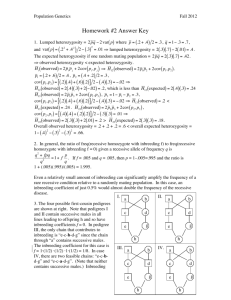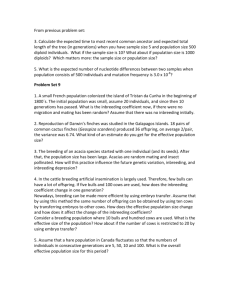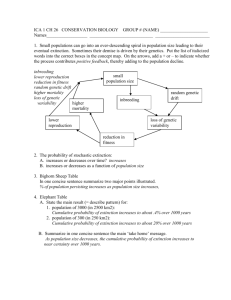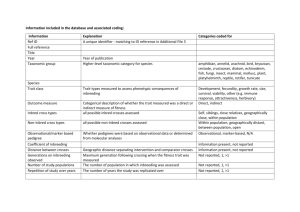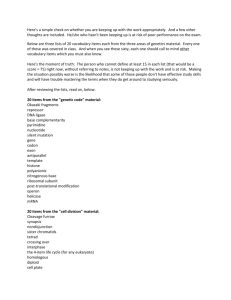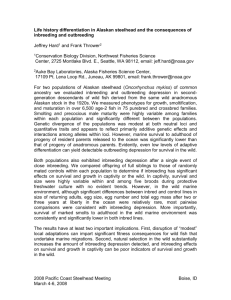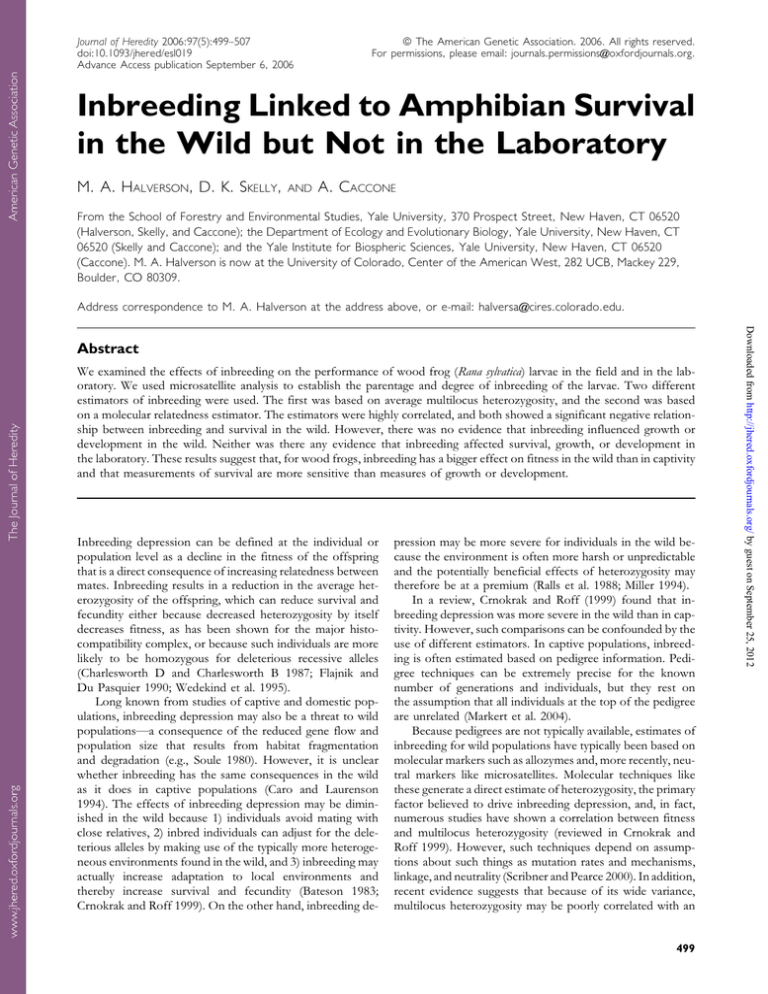
Journal of Heredity 2006:97(5):499–507
doi:10.1093/jhered/esl019
Advance Access publication September 6, 2006
ª The American Genetic Association. 2006. All rights reserved.
For permissions, please email: journals.permissions@oxfordjournals.org.
Inbreeding Linked to Amphibian Survival
in the Wild but Not in the Laboratory
M. A. HALVERSON, D. K. SKELLY,
AND
A. CACCONE
From the School of Forestry and Environmental Studies, Yale University, 370 Prospect Street, New Haven, CT 06520
(Halverson, Skelly, and Caccone); the Department of Ecology and Evolutionary Biology, Yale University, New Haven, CT
06520 (Skelly and Caccone); and the Yale Institute for Biospheric Sciences, Yale University, New Haven, CT 06520
(Caccone). M. A. Halverson is now at the University of Colorado, Center of the American West, 282 UCB, Mackey 229,
Boulder, CO 80309.
Address correspondence to M. A. Halverson at the address above, or e-mail: halversa@cires.colorado.edu.
We examined the effects of inbreeding on the performance of wood frog (Rana sylvatica) larvae in the field and in the laboratory. We used microsatellite analysis to establish the parentage and degree of inbreeding of the larvae. Two different
estimators of inbreeding were used. The first was based on average multilocus heterozygosity, and the second was based
on a molecular relatedness estimator. The estimators were highly correlated, and both showed a significant negative relationship between inbreeding and survival in the wild. However, there was no evidence that inbreeding influenced growth or
development in the wild. Neither was there any evidence that inbreeding affected survival, growth, or development in
the laboratory. These results suggest that, for wood frogs, inbreeding has a bigger effect on fitness in the wild than in captivity
and that measurements of survival are more sensitive than measures of growth or development.
Inbreeding depression can be defined at the individual or
population level as a decline in the fitness of the offspring
that is a direct consequence of increasing relatedness between
mates. Inbreeding results in a reduction in the average heterozygosity of the offspring, which can reduce survival and
fecundity either because decreased heterozygosity by itself
decreases fitness, as has been shown for the major histocompatibility complex, or because such individuals are more
likely to be homozygous for deleterious recessive alleles
(Charlesworth D and Charlesworth B 1987; Flajnik and
Du Pasquier 1990; Wedekind et al. 1995).
Long known from studies of captive and domestic populations, inbreeding depression may also be a threat to wild
populations—a consequence of the reduced gene flow and
population size that results from habitat fragmentation
and degradation (e.g., Soule 1980). However, it is unclear
whether inbreeding has the same consequences in the wild
as it does in captive populations (Caro and Laurenson
1994). The effects of inbreeding depression may be diminished in the wild because 1) individuals avoid mating with
close relatives, 2) inbred individuals can adjust for the deleterious alleles by making use of the typically more heterogeneous environments found in the wild, and 3) inbreeding may
actually increase adaptation to local environments and
thereby increase survival and fecundity (Bateson 1983;
Crnokrak and Roff 1999). On the other hand, inbreeding de-
pression may be more severe for individuals in the wild because the environment is often more harsh or unpredictable
and the potentially beneficial effects of heterozygosity may
therefore be at a premium (Ralls et al. 1988; Miller 1994).
In a review, Crnokrak and Roff (1999) found that inbreeding depression was more severe in the wild than in captivity. However, such comparisons can be confounded by the
use of different estimators. In captive populations, inbreeding is often estimated based on pedigree information. Pedigree techniques can be extremely precise for the known
number of generations and individuals, but they rest on
the assumption that all individuals at the top of the pedigree
are unrelated (Markert et al. 2004).
Because pedigrees are not typically available, estimates of
inbreeding for wild populations have typically been based on
molecular markers such as allozymes and, more recently, neutral markers like microsatellites. Molecular techniques like
these generate a direct estimate of heterozygosity, the primary
factor believed to drive inbreeding depression, and, in fact,
numerous studies have shown a correlation between fitness
and multilocus heterozygosity (reviewed in Crnokrak and
Roff 1999). However, such techniques depend on assumptions about such things as mutation rates and mechanisms,
linkage, and neutrality (Scribner and Pearce 2000). In addition,
recent evidence suggests that because of its wide variance,
multilocus heterozygosity may be poorly correlated with an
499
Downloaded from http://jhered.oxfordjournals.org/ by guest on September 25, 2012
Abstract
Journal of Heredity 2006:97(5)
Methods
Field Experiments
Two different ponds known as Quarry and Little Thing, hereafter called LT pond, in the Yale-Myers forest in northeast
Connecticut were used in this study. Quarry is the closest
wood frog breeding pond to LT pond; it lies less than
50 m away. LT pond is a smaller (pond full surface area 5
79 m2) and shallower (pond full maximum depth 5
65 cm) pond than Quarry (pond full surface area 5 197 m2,
pond full maximum depth 5 110 cm). LT pond receives
somewhat more direct sunlight than Quarry because it
has less forest canopy cover, but the difference is small
(Halverson et al. 2002; Halverson, unpublished data). Fewer
amphibian species and fewer invertebrate wood frog predators live in LT pond than in Quarry (Halverson and
Freidenburg, unpublished data).
In February 2002, we surrounded LT pond with a drift
fence made of 1-m aluminum window screening before
the wood frog breeding season began. Pit traps were located
every 5 m around the inside and outside of the fence. We
checked the traps and searched the pond exhaustively every
day from 8 March 2002 to 7 April 2002. There was no more
calling and no more egg masses appeared in the pond after
this date. We weighed, measured snout-ischium length, and
took a toe clip from all adult wood frogs captured on the
outside of the fence during this time and released them
on the inside of the fence. Toe clips were stored in 70% alcohol for later analysis. Other vertebrates captured in the
traps were released on the opposite side of the fence from
500
where they were found. We marked and documented all
egg masses. To count the eggs, we gently sandwiched each
mass in situ between a white background and a clear piece
of plastic and took a photograph with a digital camera.
We counted the eggs in the photographs by marking each
one in ArcView 3.2. We also collected 20–30 embryos from
at least 3 different parts of each egg mass as soon as the egg
mass was discovered and raised them in the laboratory until
they hatched. The hatchlings were euthanized and stored in
70% alcohol for later analysis. We opened sections of the
fence after the last wood frog egg mass appeared to allow
free access to the pond by other organisms. On 26 June
2002, when it appeared that wood frog larvae in the pond
were approaching metamorphosis, we again closed the fence
and checked the traps every day. We closed the traps and
opened the fence on 27 July 2002, 14 days after the pond
dried up and 13 days after the last metamorph was found
in a trap. All wood frog metamorphs captured on the inside
of the fence were weighed, and a toe clip was taken and
stored in 70% alcohol. To avoid confusion, all wood frog
metamorphs captured on the outside of the fence were released on the outside of the fence.
In 2003, we surrounded Quarry with a drift fence and
a similar array of pit traps. The same sampling protocol used
in LT pond in 2002 was used in Quarry in 2003. However,
unlike in LT pond in 2002, we kept the drift fences up and the
traps open for 48 days after the last egg masses appeared to
capture adult frogs leaving the pond. We made this change to
the protocol because we suspected that some frogs may have
overwintered inside the fence. All unclipped adult frogs captured on the inside of the fence were measured, weighed, and
toe-clipped and released on the outside.
Laboratory Experiment
Not all the embryos collected from Quarry in 2003 were
euthanized immediately on hatching. Instead, some of the
hatchlings from each egg mass were raised in the laboratory.
The sampled embryos were stored in an incubator at 8 C
with the lights on for 12 h a day from the time they were
collected until 18 April 2003. They were then moved to
an incubator in which there were 2 cycles: the lights were
on and the temperature was 14 C for 12 h a day, and the
lights were off and the temperature was 12 C for 12 h
a day. These temperatures approximated the temperature
regimes measured in the ponds in previous years. On 28 April
2003, after all developing embryos had hatched, one hatchling from each egg mass was combined with other hatchlings
from the same pond in a clear plastic container with 3.5 l of
aged, dechlorinated tap water. This treatment was replicated
5 times such that there were 5 containers with 25 hatchlings
representing the 25 egg masses found in Quarry in 2003.
These containers were placed in an incubator that was lit
and set to 14 C for 12 h a day and dark and 12 C for
12 h a day. As the density of the larvae in the laboratory
experiment was higher than we estimate it to be in the wild,
we changed the water frequently (every 3–4 days) and gave
each container fresh food after every water change. To
Downloaded from http://jhered.oxfordjournals.org/ by guest on September 25, 2012
individual’s inbreeding coefficient. Although some studies
have suggested that microsatellite heterozygosity-fitness correlations are the result of generalized effects (e.g., Lesbarreres
et al. 2005), others suggest that these correlations are best explained by linkage between the neutral markers and loci for
which heterozygosity confers a fitness advantage (Hansson
and Westerberg 2002; Balloux et al. 2004; Slate et al. 2004).
One means of minimizing the disadvantages of pedigree
and microsatellite inbreeding estimates is to combine the 2
techniques (Pemberton 2004). In this study, we used a combination of these methods to estimate inbreeding in a wild
population of wood frogs (Rana sylvatica) and evaluate its
effects on growth, development, and survival. Amphibians
and especially wood frogs have been commonly used in fitness studies, providing a broad context for this study (Wilbur
1980; Berven 1990). We used microsatellite analysis 1) to evaluate the relatedness of the adults in a breeding population and
2) to establish the parentage of the offspring. With this information, we estimated the level of inbreeding of the offspring
with 2 techniques as follows: 1) a simple heterozygosity measure and 2) a measure based on relatedness estimator by
Queller and Goodnight (1989) that incorporates information
about the allele frequencies in the population as a whole. To
facilitate a comparison of the effects of inbreeding in the wild
and in captivity, we also collected embryos from the population under study in the wild and raised them in the laboratory.
Halverson et al. Amphibian Inbreeding Effects
Table 1. Summary statistics for the microsatellite loci used in this study
Locus
C11
C23
C41
C83
D20
D32
D40
D55
D77
D88
All loci
No. of
alleles
H(O)
H(E)
18
7
12
5
19
17
20
17
25
24
0.85
0.436
0.778
0.744
0.765
0.856
0.837
0.785
0.936
0.922
0.903
0.455
0.833
0.715
0.897
0.889
0.869
0.889
0.917
0.933
Exclusion
probability 1
Exclusion
probability 2
HWE
probability
HWE
significance
0.664
0.109
0.506
0.284
0.65
0.626
0.596
0.626
0.707
0.755
0.999
0.798
0.252
0.676
0.451
0.788
0.77
0.747
0.771
0.828
0.86
0.999
0.104
0.299
0.025
0.083
,0.001
0.481
0.841
0.096
0.689
0.299
NS
NS
NS
NS
S
NS
NS
NS
NS
NS
accommodate the growth of the larvae, the amount of food
given to individual containers increased from 0.1 g of food at
the beginning of the experiment to 0.5 g at the end. All containers received the same amount of food. The food consisted
of 3 parts rabbit chow and 1 part fish food. On 19 June 2003,
we euthanized all the larvae that remained in the containers
and stored them in 70% alcohol. Preserved larvae were measured, and their developmental stage was assessed (Gosner
1960). Part of the tail was removed for molecular analysis.
Molecular Analysis
We extracted DNA from the toes of the adults and portions
of the tails of the larvae using the guidelines and materials in
the Puregene DNA extraction kit (Gentra Systems, Minneapolis, MN; http://www.gentra.com) and suspended the
product in 50 ll of the DNA hydration solution.
We analyzed 10 microsatellite loci described by Julian and
King (2003) (RsyC11, RsyC23, RsyC41, RsyC83, RsyD20,
RsyD32, RsyD40, RsyD55, RsyD77, and RsyD88). Polymerase chain reactions (PCRs) were carried out in 10-ll volumes
containing 1X Applied Biosystems PCR Buffer, 2 mM
MgCl2, 5 New England Biolabs Purified BSA, 0.4 lM
of each primer, 0.2 mM of each dNTP, and 0.5 units of Applied Biosystems AmpliTaq DNA Polymerase. The products were resolved on a 4% polyacrylamide sequencing gel on
an ABI 377 sequencing machine and analyzed and scored using ABI Genescan and Genotyper softwares.
We used CERVUS software to analyze the allele frequencies of the sampled adults for Hardy–Weinberg equilibrium,
observed and expected heterozygosity, and exclusion probabilities as described by Marshall et al. (1998). One of the loci
(RsyD20) had a significant departure from Hardy–Weinberg
equilibrium and was dropped from the analysis (Table 1).
Parentage and Inbreeding Analysis
For the purposes of the parentage analysis, it was necessary to
determine whether we had sampled all the adults that might
have bred. The presence of unclipped adults in traps on the
inside of the fence in Quarry in 2003 suggests that we did not,
perhaps because some individuals overwintered inside the
fence. Because adult frogs were marked with toe clips and
captured going in and out of the pond in 2003, it was possible
to use mark-recapture analysis to estimate the number of
breeding adults in a pond in a given year and the proportion
that were sampled. We did not capture adults exiting LT
pond in 2002, so in that case, we used the estimates of
the proportion sampled from Quarry in 2003.
To maximize the power of the parentage analysis, we first
assigned adult females to egg masses. We analyzed which
females were compatible with each embryo based on exclusion analysis. Potential null alleles were handled in the most
conservative way possible: all homozygotes were treated as
heterozygotes with the detected allele and a null allele (Jones
and Ardren 2003). This meant that a homozygous adult could
not be excluded as the parent of a homozygous offspring at
any given locus. We then examined which females’ genotypes
were compatible with the genotypes of all the embryos from
a given egg mass, allowing for one mutation or mistyping
error per embryo and assigned parentage accordingly.
To establish a confidence level in the parentage assignments, we used a Monte Carlo simulation in which pseudoadults were generated based on the allele frequencies in the
population as a whole. The proportion of simulations in
which a pseudoadult was more likely to be the mother of
a sampled egg mass was multiplied by the estimated number
of adults that were not sampled in a pond during a given year.
Mutations and mistyping errors were allowed and accounted
for in the Monte Carlo analysis.
Because we could not assume that all embryos in an egg
mass had the same father, we established paternity of each of
the embryos individually using CERVUS (Marshall et al.
1998). As the maternity of all the egg masses was established
and the maternal alleles in the offspring could be removed
from the analysis, the power of CERVUS to assign paternity
was greatly increased. Parameters necessary for this analysis
501
Downloaded from http://jhered.oxfordjournals.org/ by guest on September 25, 2012
H(O) is the observed heterozygosity. H(E) is the expected heterozygosity based on the number of alleles. Exclusion probability 1 reflects the probability that
a given locus will be able to exclude an individual as the parent when there is no information about the other parent. Exclusion probability 2 reflects the
probability that a given locus will be able to exclude an individual as the parent when one parent is known. HWE probability is the probability that a locus at
Hardy–Weinberg equilibrium would generate the observed allele combinations in the population for a given locus. HWE significance is the significance of the
HWE probability values after a Bonferroni correction has been applied where S is significant and NS is not significant.
Journal of Heredity 2006:97(5)
502
or heterozygosity. The power of the regression analyses
for the inbreeding coefficient and heterozygosity versus survival in these experiments was estimated using the methods
and software described by Dupont and Plummer (1998).
We used Monte Carlo techniques to perform sensitivity
analyses on those regression analyses that showed a significant relationship. In the first test, we selected the 14 metamorphs that were of questionable parentage, randomly
reassigned their parentage to other known breeding pairs,
and redid the least-squares regression analyses 1000 times.
In the second test, we randomly selected twice this number
of metamorphs (more than 10% of the total number of metamorphs analyzed), randomly reassigned their parentage to
other known breeding pairs, and redid the least-squares regression analyses 1000 times.
To determine whether the wood frog adults avoided inbreeding, an analysis of variance (ANOVA) was used to compare the average pairwise relatedness of the individuals that
bred and the average pairwise relatedness of the individuals
that did not breed in each pond.
Results
Molecular Analysis
The microsatellite loci used here were all polymorphic, with
5–25 alleles each (Table 1). Expected heterozygosities ranged
from 0.455 to 0.933. In most loci, the observed heterozygosity was somewhat lower, suggesting that there may have been
some null alleles. However, only one locus (RsyD20) showed
a significant departure from Hardy–Weinberg equilibrium
and was dropped from the analysis. The exclusion probabilities for a parent given no information about the other parent
ranged from 0.109 to 0.755 with a combined exclusion probability of 0.999. The exclusion probabilities for a parent when
the other parent is known ranged from 0.252 to 0.860 with
a combined exclusion probability of 0.999.
Parentage Analysis
Five egg masses were laid in LT pond in 2002 with an average
of 664 eggs apiece (SD 5 172). We captured 76 males and 35
females in Quarry in 2003. Twenty-five egg masses were laid
in Quarry in 2003, with an average of 523 eggs apiece (SD 5
220). DNA from 6 embryos from each of the 5 egg masses
in LT pond in 2002 and 5 embryos from each of the 25 egg
masses Quarry in 2003 was extracted and analyzed. Three
of the embryos (each from a different egg mass) from Quarry
failed to amplify any products at any locus, probably because the extraction failed, and were not used in the analysis
(Table 2).
With 4 exceptions, based on the exclusion analysis, we
found one and only one female with a genotype that was
compatible based on strict Mendelian inheritance with the
genotype of all the embryos in the egg mass and assigned
maternity accordingly. For 3 of the 4 unassigned egg masses,
a potential mother was found that was only incompatible
Downloaded from http://jhered.oxfordjournals.org/ by guest on September 25, 2012
include the estimated total number of adult males, the proportion captured, and the estimated mutation or mistyping
error rate. The first 2 parameters were estimated by markrecapture analysis. The latter was estimated from the maternity analysis of the embryos.
Finally, we assigned maternity and paternity to all the
metamorphs captured in the field and to the larvae raised
in the laboratory. Because of the quantity of samples and because, in most cases, they conferred sufficient discriminatory
power, only the 8 most polymorphic loci were used in these
analyses (RsyC11, RsyC23, RsyC41, RsyD32, RsyD40,
RsyD55, RsyD77, and RsyD88) (Table 1). We first established the most likely mother using CERVUS. We then used
CERVUS to assign the most likely father.
The null hypothesis in all cases was that there was no multiple paternity. Thus, in the few cases where CERVUS found
multiple different most likely fathers for the offspring of a
single mother, the results were examined more carefully. If,
allowing for zero or one mutation or mistyping errors, the
genotype of the offspring could be explained without multiple paternity, it was so done.
The relatedness of the adults was estimated with the
microsatellite data, using the method described by Queller
and Goodnight (1989) and SPAGEDI software (Hardy
and Vekemans 2002). This estimator weighs the number
of alleles shared by individuals and the frequencies of those
alleles in the population as a whole to estimate relatedness.
Because the coefficient of inbreeding of an individual is, by
definition, one-half the coefficient of relatedness of the individual’s parents, the coefficient of inbreeding for all the embryos and metamorphs was defined as such for this analysis
(Hartl and Clark 1997). Based on the parentage analysis of
egg masses and metamorphs, we assumed that all individuals
in an egg mass were full sibs. To facilitate comparison with
previous studies, the average multilocus heterozygosity of all
the offspring in an egg mass was also calculated and analyzed
from the parental genotypes. We compared the relationship
between average multilocus heterozygosity and the estimated
inbreeding coefficient.
We calculated the survival rate for a given sibship in the
field experiment as the ratio of metamorphs to embryos. Linear regression was used to compare the effects of the estimated inbreeding coefficient and heterozygosity on the
survival, size, and date of capture of the metamorphs from
the field experiment. The date of capture of each metamorph
is probably not perfectly correlated with the actual date of
metamorphosis because some metamorphs may have taken
longer to exit the pond than others. However, it is the best
estimator we could use in the field situation, and we refer
to this as the date of metamorphosis in the rest of the
manuscript.
In the laboratory experiment, we used linear regression to
determine whether the proportion of the collected embryos
that successfully hatched was a function of the coefficient of
inbreeding or heterozygosity. We also used linear regression
to determine whether the average size, developmental stage,
or proportion of hatchlings that survived in the laboratory
experiment was a function of the coefficient of inbreeding
Halverson et al. Amphibian Inbreeding Effects
Table 2. Summary of the parentage analysis for the embryos, metamorphs, and larvae raised in the laboratory
LT pond
Quarry
No. of egg masses
Average no. of embryos per egg mass
No. of embryos/egg mass analyzed
No. of embryos not analyzed
No. of egg masses in which all analyzed embryos were assigned to one captured female: strict
Mendelian inheritance
No. of egg masses in which all analyzed embryos were assigned to one captured female: one mutation
No. of egg masses in which all analyzed embryos were assigned to one captured male: strict
Mendelian inheritance
No. of egg masses in which all analyzed embryos were assigned to one uncaptured male: strict
Mendelian inheritance
No. egg masses in which all analyzed embryos were assigned to one captured male: one mutation
No. of metamorphs
No. of metamorphs assigned to a known parent pair: strict Mendelian inheritance
No. of metamorphs assigned to a known parent pair: one mutation
No. of metamorphs not analyzed
No. of laboratory larvae analyzed
No. of larvae from laboratory matching known parent pair: strict Mendelian inheritance
No. of larvae from laboratory matching known parent pair: one mutation
5
664
6
0
5
25
523
5
3a
21
0
4
4
22
0
3
1
43
41
1
1
NA
NA
NA
0
292
286
4
2
104
103
1
As indicated in the table, all individuals for which the parentage was assigned were compatible with the assigned parents under ‘‘strict Mendelian inheritance,’’
or given ‘‘one mutation.’’ These results are described in more detail in the text.
a
Each of these embryos came from a different egg mass.
with one embryo at one locus, and in the latter 2 of these
cases, the alleles only differed by one repeat unit. Such misfits
are consistent with a mutation or mistyping error at one locus
in the offspring. In the fourth case, the most compatible
mother was incompatible with 4 out of 5 embryos at the same
locus, a situation that might have occurred if this putative
mother was mistyped or if there was a premeiotic mutation
at that locus.
The Monte Carlo analysis showed that it was extremely
unlikely (P , 0.01) that a female not sampled would have
been compatible with any of the sampled egg masses under
a strict exclusion analysis or even if 1–3 mutations or mistyping errors at the level of the embryos or the mother were
allowed. We thus determined that a mutation or mistyping
error had occurred in the case of the 4 unassigned egg masses
and assigned maternity accordingly.
The paternity analysis of the embryos revealed little or no
evidence for multiple paternity. With 6 exceptions, the same
male was the most likely father of all the embryos in an egg
mass. In the case of 3 of the remaining egg masses, 3 of the
embryos within a given egg mass were found to have different most likely fathers. However, the genotypes of all the embryos from a given egg mass could also have been explained if
they were fertilized by a single male that was not captured. It
appears more likely that a single male that was not captured
fertilized these eggs than that multiple different males with
very similar genotypes all mated with a single female. In
the case of another two of the egg masses, CERVUS determined that one embryo had a different more likely father than
the other embryos in the mass. However, the genotype of the
father of the other embryos in the mass was also compatible
with the genotype of the single embryo under strict Mendelian inheritance. Again, it appears more likely that the same
male fertilized all the embryos in these egg masses than that
multiple males with very similar genotypes mated with the
same female. Finally, one embryo in one egg mass was
not compatible with the other embryos in the egg mass under
strict Mendelian inheritance, but would have been so given
one mutation. This was deemed the most parsimonious explanation, and paternity was assigned accordingly (Table 2).
There were 43 metamorphs captured inside the fence in
LT pond in 2002 and 292 metamorphs captured inside the
fence in Quarry in 2003. Though we are not able to state it
with any certainty, we assume that the fence was reasonably
impermeable to the metamorphs and that if any did manage
to get out of the fenced area without being trapped in the
buckets, they were a sufficiently small and random group that
they did not bias the sample of metamorphs we were able to
collect. Two of the metamorphs failed to amplify any alleles
at any locus, probably due to an extraction error, and were
dropped from the analysis. For 316 of the 333 metamorphs
that were analyzed from both ponds, the most likely parents,
according to CERVUS, were pairs that matched one of the
parent pairs found in the embryo analysis. Of the remaining
metamorphs, 11 had genotypes that were compatible with the
genotypes from one of the known parent pairs under strict
Mendelian inheritance. Five had genotypes that would be
compatible with the genotypes from one of the known parent
pairs under strict Mendelian inheritance given one mutation.
This was deemed the most parsimonious explanation, and
parentage was assigned accordingly (Table 2).
For one metamorph from LT pond in 2002, there were
no mothers compatible with its genotype without mutations
or mistyping errors at 3 different loci and no potential fathers
without mutations or mistyping errors at 2 different loci. A
more parsimonious explanation is that this metamorph came
503
Downloaded from http://jhered.oxfordjournals.org/ by guest on September 25, 2012
Pond
Journal of Heredity 2006:97(5)
from another pond and somehow slipped through the fence
into LT pond before getting caught in one of the inside buckets. It was therefore dropped from further analysis. Every
sibship was represented in the metamorphs by a minimum
of 1 and a maximum of 18 individuals in LT pond in
2002 and by a minimum of 2 and a maximum of 37 individuals in Quarry in 2003.
According to CERVUS, for 91 of the 104 larvae that survived the laboratory experiment and were analyzed, the most
likely parents were pairs that matched one of the parent pairs
found in the embryo analysis. Of the remaining 13 larvae, 12
had genotypes that were compatible with the genotypes from
one of the known parent pairs under strict Mendelian inheritance and 1 would have been strictly compatible given one
mutation. Parentage was assigned accordingly.
On an experiment-wide basis, the probability that there
were instances of multiple paternity that we failed to detect
depends on the number of eggs in the egg mass and the percentage of eggs that were fertilized by another male. On average, across all ponds, in all pond years, there were 547 eggs
in an egg mass, and we examined paternity in no less than 5
eggs from every egg mass. If we assume that another male
fertilized 10% of the eggs in an average egg mass, then there
is only a 41% chance that we would have detected multiple
paternity in the 5 embryos examined. However, there were,
on average, 10 metamorphs from every egg mass, which
increases the sample size to 15 and the detection probability
to 79%. On a study-wide basis, the probability of detection
increases even more. Even if multiple paternity occurred in
only 10% of the 30 egg masses analyzed, using the parameters
described in the last instance, there is less than a 1% chance
that we would have failed to detect multiple paternity in at
least one egg mass. Thus, we assume that multiple paternity
did not occur in these ponds in these years.
504
Figure 2. Proportion of individuals from a given egg mass
that survived to metamorphosis as a function of the average
multilocus heterozygosity of the individuals in the egg mass
in Quarry in 2003. The line represents the least-squares
regression line.
Inbreeding Analysis
Linear regression showed that there was a strong relationship
between the estimated inbreeding coefficient and the average
multilocus heterozygosity (F1,20 5 156.50, P , 0.01, R2 5
0.89; Figure 1).
Because we did not know the genotype of the father for 3
of the egg masses in Quarry in 2003, we could not define the
coefficient of inbreeding or average heterozygosity for these
sibships. We thus dropped these sibships from the inbreeding
analysis.
For individuals in Quarry in 2003, linear regression with
the 22 analyzed sibships showed a significant negative relationship between the estimated inbreeding coefficient and
survival (F1,20 5 8.09, P 5 0.01, R2 5 0.29) and a significant
positive relationship between heterozygosity and survival
(F1,20 5 8.50, P , 0.01, R2 5 0.30; Figure 2). For those individuals that reached metamorphosis in Quarry in 2003, linear
regression showed no significant relationship between the
estimated inbreeding coefficient and the average weight
(F1,20 5 0.44, P 5 0.52, R2 5 0.021), average date of metamorphosis (F1,20 5 2.45, P 5 0.13, R2 5 0.11), or average
number of days to metamorphosis (F1,20 5 2.73, P 5 0.12,
R2 5 0.056). Results for heterozygosity were similar (weight:
F1,20 5 0.06, P 5 0.81, R2 ,0.01; date: F1,20 5 2.57, P 5
0.13, R2 5 0.11; days: F1,20 5 2.46, P 5 0.13, R2 5 0.11).
For the embryos raised in the laboratory, linear regression
showed no significant relationship between the estimated inbreeding coefficient and hatching success (F1,20 5 2.85, P 5
0.11, R2 5 0.11) or between heterozygosity and hatching success (F1,20 5 3.26, P 5 0.085, R2 5 0.13). For the hatchlings
from Quarry in 2003 that were raised in the laboratory, linear
regression showed no significant relationship between the
estimated inbreeding coefficient and survival (F1,20 5 0.078,
Downloaded from http://jhered.oxfordjournals.org/ by guest on September 25, 2012
Figure 1. Estimated average inbreeding coefficient of all
the embryos in each egg masses in Quarry in 2003 versus
estimated average multilocus heterozygosity. The least-squares
regression line shows the strong negative relationship between
these 2 estimators.
Halverson et al. Amphibian Inbreeding Effects
Discussion
In this study, inbreeding (estimated either through multilocus heterozygosity or relatedness estimator of Queller and
Goodnight [1989] ) negatively affected the survival of wood
frog larvae in the wild (Figure 2). The effects were large; there
was more than a 7-fold difference in the survival of the least
and most heterozygous individuals in Quarry in 2003. However, in the laboratory, inbreeding had no effect on the hatching success of the embryos or the survival of the larvae.
Neither did it have any significant effect on size or development of the larvae in the laboratory or the field. Although
interesting, it is difficult to interpret the latter results because
it is possible that the smallest or least-developed individuals
in the field did not survive as well and thus were not measured. The results from the field experiments in LT pond in
2002 yielded no significant results for any comparisons; however, the sample size and thus the power were low.
Determining parentage and then estimating average multilocus heterozygosity and the Queller and Goodnight (1989)
inbreeding coefficient for an entire sibship as we did here has
several advantages over measuring the heterozygosity of the
individuals alone. First, it utilizes more information; it makes
use of the 4 alleles at a locus in the parental generation instead
of the 2 alleles present in individual offspring. This combination of pedigree and microsatellite techniques provides
a better estimate of inbreeding at the whole-genome level
and lessens the effects of linkage disequilibrium (Pemberton
2004). Second, the Queller and Goodnight (1989) inbreeding
coefficient makes use of information about the allele frequencies in the population as a whole to determine relatedness.
This information could not be generated reliably solely from
the offspring generation because the presence of sibships
would skew estimates. It is interesting to note, however, that
heterozygosity and the Queller and Goodnight (1989) inbreeding coefficient were highly correlated (Figure 1). Third,
it minimizes the number of microsatellites that must be analyzed because not all loci must be analyzed in the offspring
generation—only those necessary to determine parentage.
The results from Quarry in 2003 are consistent with
results from studies with other amphibian species (e.g., Rowe
et al. 1999; Lesbarreres et al. 2005), with the predictions of
Ralls et al. (1988), and with the results of other studies that
have shown inbreeding to have a stronger effect on survival
in the wild than in the laboratory (Chen 1993; Jimenez et al.
1994; reviewed in Crnokrak and Roff 1999). There are several
possible explanations for such contrasting results. First, the
decreased heterozygosity that accompanies inbreeding might
lead to individuals that are more subject to predation—a factor that was only present in the wild. Second, such results
could be generated if competition was more severe in the
wild, and inbreeding had a negative effect on competitive
abilities. Although growth and development—the traits that
are most likely to affect predation and competition—were
not correlated with inbreeding in either experiment, such
an affect might have been hidden by the fact that the slower
growing and developing individuals were less likely to survive
to metamorphosis and thus be sampled (e.g., Rowe and
Beebee 2005). Third, many abiotic factors may be more harsh
in the wild than in the laboratory, and heterozygosity may be
at a premium in harsher environments. Chemical differences
between the water in the pond and the treated tap water used
505
Downloaded from http://jhered.oxfordjournals.org/ by guest on September 25, 2012
P 5 0.79, R2 , 0.01) or between heterozygosity and survival
(F1,20 5 0.38, 0.54, R2 5 0.02). The power of each of these
linear regression analyses, assuming the regression coefficients were the same as in the pond, was 0.73 and 0.76, respectively (Dupont and Plummer 1998). Nor was there
a significant relationship between the estimated inbreeding
coefficient and the average size of the larvae (F1,20 5
0.97, P 5 0.34, R2 5 0.05) or average developmental stage
(F1,20 5 0.93, P 5 0.35, R2 5 0.04). Results for heterozygosity were similar (weight: F1,20 5 1.11, P 5 0.30, R2 5 0.05;
developmental stage: F1,20 5 0.56, P 5 0.46, R2 5 0.03).
The sensitivity analyses showed that the significant linear
regressions of inbreeding coefficient versus survival and heterozygosity versus survival were very robust. When the 14
metamorphs of questionable parentage in Quarry in 2003
were randomly reassigned to other known breeding pairs,
the inbreeding coefficient was significantly negatively related
to survival in 97.9% and heterozygosity was significantly
positively related to survival in 99.8% of the 1000 tests
performed. The R2 value was as high or higher than the value
found for the original data in 49.9% of the 1000 tests performed for inbreeding coefficient versus survival and in
24.6% of the 1000 tests performed for heterozygosity versus
survival. When 28 metamorphs were randomly selected and
reassigned to other known breeding pairs, the inbreeding coefficient was significantly negatively related to survival in
88.6% and heterozygosity was significantly positively related
to survival in 92.0% of the 1000 tests performed. The R2
value was as high or higher than the value found for the original data in 55.2% of the 1000 tests performed for inbreeding
coefficient versus survival and in 32.4% of the 1000 tests performed for heterozygosity versus survival.
For individuals in LT pond in 2002, linear regression with
the 5 analyzed sibships showed no significant relationship
between the estimated inbreeding coefficient and survival
(F1,3 5 0.29, P 5 0.62, R2 5 0.09) or between heterozygosity
and survival (F1,3 5 0.31, P 5 0.61, R2 5 0.09). However, the
trends for these regressions were in the same direction as for
the Quarry metamorphs in 2003. Linear regression also did
not show any significant relationship between the estimated
inbreeding coefficient and the average weight (F1,3 5 0.36,
P 5 0.59, R2 5 0.11), average date of metamorphosis (F1,3 ,
0.01, P 5 0.94, R2 , 0.01), or average number of days until
metamorphosis (F1,3 5 0.068, P 5 0.81, R2 5 0.02) of those
individuals that reached metamorphosis in LT pond in 2002.
Results for heterozygosity were similar (weight: F1,3 5 0.69,
P 5 0.47, R2 5 0.19; date: F1,3 , 0.01, P 5 0.96, R2 , 0.01;
days: F1,3 5 0.28, P 5 0.63, R2 5 0.09).
Pairwise relatedness of those individuals that mated with
each other was not any different than the average pairwise
relatedness of the population as a whole (ANOVA—Quarry
2003: F1,2772 5 0.89, P 5 0.35; LT pond 2002: F1,194 5 0.16,
P 5 0.69).
Journal of Heredity 2006:97(5)
506
Barrett 2002). In addition, wood frog populations are likely
to undergo frequent bottlenecks when environmental factors
such as droughts inflict extremely high mortality on a cohort.
Such bottlenecks should eliminate many rare alleles such as
lethal recessives. In combination, these 2 factors should limit
the number of lethal recessive alleles present in wood frog
populations and thus reduce any effects they may cause
through inbreeding, as appears to be the case here.
It has also been suggested that inbreeding may be mitigated in wild populations because individuals can avoid breeding with their close relatives (Waldman et al. 1992; Crnokrak
and Roff 1999). Although wood frog larvae have been shown
to be capable of recognizing their siblings and half-siblings
(e.g., Waldman 1984; Cornell et al. 1989; Halverson et al.
2006), there was no evidence that wood frog adults avoided
inbreeding. The average pairwise relatedness of those individuals that mated with each other in each pond was not significantly different than the average pairwise relatedness of the
population of adults as a whole. Such results should not be
surprising, given the wood frog breeding system. Observation
suggests that the female has little choice in her mate and the
males have little reason to avoid inbreeding so long as it does
not prevent them from breeding with less-related individuals.
In conclusion, it should be noted that this is not the first
study of inbreeding effects on wood frog larvae. As was found
here with microsatellites, Wright and Guttman (1995) found
no correlation between size and allozyme heterozygosity in
wood frog larvae in the wild. However, in that study, the
effects of allozyme heterozygosity on survival and development were not assessed. The results of this study demonstrate
the importance of measuring various components of fitness,
especially survival, when assessing the effects of inbreeding.
They also demonstrate the importance of studying inbreeding
under natural conditions.
Acknowledgments
We thank Shannon Julian and Tim King for providing us with a prepublication copy of their manuscript. Kristin Saltonstall and Susan Bolden provided
assistance in the field and in the laboratory. The Yale Institute for Biospheric
Studies Center for Field Ecology and Molecular Systematics and Conservation Genetics Laboratory provided the funds and laboratory space for this
study. Stephen C. Stearns, Oswald J. Schmitz, and Mark C. Urban provided
valuable comments on the manuscript.
References
Balloux F, Amos W, Coulson T. 2004. Does heterozygosity estimate inbreeding in real populations? Mol Ecol 13:3021–3031.
Bateson P. 1983. Optimal outbreeding. In: Bateson P, editor. Mate choice.
Cambridge: Cambridge University Press. p 257–277.
Berven KA. 1990. Factors affecting population fluctuations in larval and
adult stages of the wood frog (Rana sylvatica). Ecology 71:1599–1608.
Caro TM, Laurenson MK. 1994. Ecological and genetic factors in conservation: a cautionary tale. Science 263:485–486.
Charlesworth D, Charlesworth B. 1987. Inbreeding depression and its evolutionary consequences. Annu Rev Ecol Syst 18:237–268.
Chen X. 1993. Comparison of inbreeding and outbreeding in hermaphroditic
Arianta arbustorum (L.) (land snail). Heredity 71:456–461.
Downloaded from http://jhered.oxfordjournals.org/ by guest on September 25, 2012
in the laboratory may have made the pond a harsher environment. Likewise, hydroperiod may have been important; the
ponds in which these studies were conducted are temporary,
and thus, individuals that did not metamorphose quickly
enough could have died. However, no premetamorphic larvae were found in these ponds for more than a week before
the ponds dried in the years in which these experiments were
conducted. Combined with the lack of any correlation between inbreeding and growth and development, these observations suggest that chemistry, hydroperiod, and other
abiotic factors were not strong factors driving the different
results in the wild and the laboratory.
A fourth possibility that could explain the different
effects of inbreeding on survival in the field and the laboratory is that inbreeding exerts its most powerful influence during the few days that precede metamorphosis. Although the
individuals in the wild were not collected until they reached
this stage, the individuals in the laboratory were collected before any had begun this process. It is likely that metamorphosis is a stressful time for wood frogs and a period of high
mortality. For example, during this time, the larval digestive
system undergoes profound changes to make it suitable for
terrestrial food sources and the larvae stop eating (Duellman
and Trueb 1986). The larvae must also begin obtaining oxygen from lungs instead of gills during this time. And, as the
larvae resorb their tails and begin to rely on their feet for locomotion, often in crowded conditions from imminent pond
drying, they are extremely vulnerable to predation.
Fifth, and finally, it is possible that disease was more prevalent in the wild than in the laboratory and that inbreeding was
correlated with immune response. Although data are lacking,
the first part of this hypothesis seems likely. Because the water
used in the laboratory experiment was tap water that had initially been filtered and treated for human consumption, it likely
had a lesser load of parasites. In contrast, both observations in
these ponds and studies conducted elsewhere suggest that
water in natural ponds can have numerous different parasites
that can inflict widespread mortality on amphibians. The second part of the hypothesis also has strong theoretical support
and empirical support. Heterozygosity has been shown to be
very important for the functioning of the immune system and,
specifically, the major histocompatibility complex (Flajnik and
Du Pasquier 1990; Wedekind et al. 1995).
It is often suggested that inbreeding may be correlated
with fitness because inbred individuals are more likely to have
2 copies of a lethal recessive allele (Ralls et al. 1988). In extreme cases, inbred embryos that are homozygous for lethal
recessive alleles may not survive past the first few cell divisions. The lack of any significant effect of inbreeding on survival of embryos or larvae in the laboratory experiment
suggests that such lethal alleles played little role here. And
indeed, in theory, there should be fewer such alleles in populations of this species. Wood frogs have been shown to be
highly philopatric (Berven 1990) and thus should experience
higher levels of inbreeding than less philopatric species. High
levels of inbreeding across multiple generations have been
shown to expose lethal recessive alleles to selection and
thereby purge them from the gene pool (Crnokrak and
Halverson et al. Amphibian Inbreeding Effects
Cornell TJ, Berven KA, Gamboa GJ. 1989. Kin recognition by tadpoles and
froglets of the wood frog Rana sylvatica. Oecologia 78:312–316.
Miller PS. 1994. Is inbreeding depression more severe in a stressful environment? Zool Biol 13:195–208.
Crnokrak P, Barrett SCH. 2002. Purging the genetic load: a review of the
experimental evidence. Evolution 56:2347–2358.
Queller DC, Goodnight KF. 1989. Estimating relatedness using genetic
markers. Evolution 43:258–275.
Crnokrak P, Roff DA. 1999. Inbreeding depression in the wild. Heredity
83:260–270.
Pemberton J. 2004. Measuring inbreeding depression in the wild: the old
ways are best. Trends Ecol Evol 19:613–615.
Duellman WE, Trueb L. 1986. Biology of amphibians. Baltimore: Johns
Hopkins.
Ralls K, Ballou JD, Templeton A. 1988. Estimates of lethal equivalents and
the cost of inbreeding in mammals. Conserv Biol 2:185–193.
Dupont WD, Plummer WD. 1998. Power and sample size calculations for
studies involving linear regression. Control Clin Trials 9:589–601.
Rowe G, Beebee TJC. 2005. Intraspecific competition disadvantages inbred
natterjack toad (Bufo calamita) genotypes over outbred ones in a shared
pond environment. J Anim Ecol 74:71–76.
Flajnik MF, Du Pasquier L. 1990. The major histocompatibility complex of
frogs. Immunol Rev 113:47–63.
Gosner KL. 1960. A simplified table for staging anuran embryos and larvae
with notes on identification. Herpetologica 16:183–190.
Halverson MA, Skelly DK, Caccone A. 2006. Kin distribution of amphibian
larvae in the wild. Mol Ecol 15:1139–1145.
Hansson B, Westerberg L. 2002. On the correlation between heterozygosity
and fitness in natural populations. Mol Ecol 11:2467–2474.
Hardy OJ, Vekemans X. 2002. SPAGeDi: a versatile computer program to
analyse spatial genetic structure at the individual or population levels. Mol
Ecol Notes 2:618–620.
Hartl DL, Clark AG. 1997. Principles of population genetics. 3rd ed. Sunderland, MA: Sinauer Associates.
Jimenez JA, Hughes KA, Alaks G, Graham L, Lacy RC. 1994. An experimental study of inbreeding depression in a natural habitat. Science 266:
271–273.
Jones AG, Ardren WR. 2003. Methods of parentage analysis in natural populations. Mol Ecol 12:2511–2523.
Julian SE, King TL. 2003. Novel tetra-nucleotide microsatellite DNA
markers for the wood frog, Rana sylvatica. Mol Ecol Notes 3:256–258.
Lesbarreres D, Primmer SR, Laurila A, Merila J. 2005. Environmental and
population dependency of genetic variability-fitness correlations in Rana temporaria. Mol Ecol 14:311–323.
Markert JA, Grant PR, Grant BR, Keller LF, Coombs JL, Petren K. 2004.
Neutral locus heterozygosity, inbreeding, and survival in Darwin’s ground
finches (Geospiza fortis and G. scandens). Heredity 92:306–315.
Marshall TC, Slate J, Kruuk LEB, Pemberton JM. 1998. Statistical confidence
for likelihood-based paternity inference in natural populations. Mol Ecol
7:639–655.
Scribner KT, Pearce JM. 2000. Microsatellites: evolutionary and methodological background and empirical applications at individual, population and
phylogenetic levels. In: Baker AJ, editor. Molecular methods in ecology.
Malden, MA: Blackwell Science. p 235–273.
Slate J, David P, Dodds KG, Veenvliet BA, Glass BC, Broad TE, McEwan
JC. 2004. Understanding the relationship between the inbreeding coefficient
and multilocus heterozygosity: theoretical expectations and empirical data.
Heredity 93:255–265.
Soule ME. 1980. Thresholds for survival: maintaining fitness and evolutionary potential. In: Soule ME, Wilcox BA, editors. Conservation biology: an
evolutionary-ecology perspective. Sunderland, MA: Sinauer Associates.
p 151–169.
Waldman B. 1984. Kin recognition and sibling association among wood frog
(Rana sylvatica) tadpoles. Behav Ecol Sociobiol 14:171–180.
Waldman B, Rice JE, Honeycutt RL. 1992. Kin recognition and incest avoidance in toads. Am Zool 32:18–30.
Wedekind C, Seebeck T, Bettens F, Paepke AJ. 1995. MHC-dependent mate
preferences in humans. Proc R Soc Lond B Biol Sci 260:245–249.
Wilbur HM. 1980. Complex life cycles. Annu Rev Ecol Syst 11:67–93.
Wright MF, Guttman SI. 1995. Lack of an association between heterozygosity and growth rate in the wood frog, Rana sylvatica. Can J Zool 73:
569–575.
Received June 23, 2005
Accepted July 1, 2006
Corresponding Editor: Rob Fleischer
507
Downloaded from http://jhered.oxfordjournals.org/ by guest on September 25, 2012
Halverson MA, Skelly DK, Kiesecker JM, Freidenburg KL. 2002. Forest mediated light regime linked to amphibian distribution and performance. Oecologia 134:360–364.
Rowe G, Beebee TJC, Burke T. 1999. Microsatellite heterozygosity, fitness
and demography in natterjack toads, Bufo calamita. Anim Conserv 2:
85–92.

